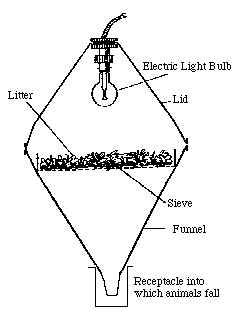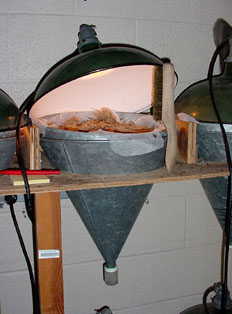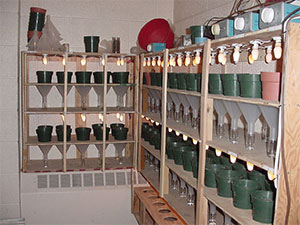|
Berlese-Tullgren apparatus
A Berlese-Tullgren extractor is a great tool for separating small land invertebrates from the litter and soil they inhabit. Many small and medium-sized invertebrates (juvenile centipedes and millipedes, small insects and their larvae, mites and springtails) can be separated from soil and litter using this method. Free of soil debris, they can be counted and identified. The material from which a Berlese-Tullgren extractor is constructed can be extremely varied, and often a functional Berlese funnel can be made from household items (a plastic soda bottle, cardboard, etc.). However different the shape, size, and material, every Berlese-Tullgren extractor consists of a funnel, a light source, a screen, and a receptacle into which the animals fall.

Berlese-Tullgren extractor.
Image source (1999): http://140.211.62.101/lessons/makentake
/berlese1.html
|

Berlese-Tullgren extractor. |
A litter sample is placed on the screen (for example, a sieve) at the top of the funnel. The screen prevents soil and litter debris from falling into the collecting container. A small lamp with a low-power light bulb (10-40 Watts) heats and dries the soil from above. The light bulb should be positioned just above the litter, but not touching it. The lower part of the funnel needs to be well-ventilated and cool to create a gradient of temperatures. As the soil dries out from the top down, the dryness stimulates the soil animals to move downward (this behaviour is called positive geotaxis). This downward movement eventually causes the soil animals to fall through the sieve into a container with a preservative (usually 75% alcohol).
With the light bulb as a source of heat, the extraction can take 5-7 days, longer if a large amount of substrate is collected, or if the substrate is wet. If a power source for the light bulb is not available, for example in field conditions, the samples can be allowed to air-dry if the weather is dry and warm, although this will slow down the extraction. Air-drying will not work for wet substrates or in rainy weather.

Smaller versions of Berlese funnel are used for multiple samples. Until ready to extract, the soil and litter containing invertebrates should be placed in plastic bags and kept in a cool, dark area. For a few days storage, a common household refrigerator is sufficient, but for long-term storage the sample needs to be kept in a cooler at ~4 degrees Celsius. To avoid damage to fragile animals, sample needs to be handled gently. In all cases soil and litter sample needs to be labelled with the date and source location.
The Berlese-Tullgren extraction method gives a biased sample of soil fauna, because it is based on specific avoidance behaviour triggered by dryness and thus best captures animals that are mobile and do not desiccate easily. Immobile larvae, endophagous nymphs and some moisture-dependant invertebrates such as nematodes are not extracted by a Berlese funnel.
|